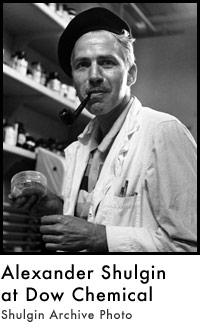 |
| Alexander "Sasha" Shulgin, the "godfather of MDMA," in his basement laboratory |
Shulgin Research
"Alexander T. Shulgin (June 17, 1925–June 2, 2014), known to friends and admirers as “Sasha”, was a biochemist and pharmacologist best known for his synthesis, creation, and personal bioassay of hundreds of novel psychoactive compounds.
Sasha was born in Berkeley, California. He first began his study of organic chemistry at Harvard University. In 1943 at the age of 18, Sasha left Harvard to join the U.S. Navy. After serving in World War II, Sasha returned to Berkeley to earn his PhD in biochemistry from the University of California, Berkeley, and complete post-doctoral work in the fields of psychiatry and pharmacology at University of California, San Francisco. After a short period working at Bio-Rad Laboratories as a research director, he joined Dow Chemical Company as a senior research chemist.
While at Dow, Sasha’s interest in psychopharmacology was inspired by a profound experience with mescaline:
“I first explored mescaline in the late ’50s… Three-hundred-fifty to 400 milligrams. I learned there was a great deal inside me.”— Alexander Shulgin, Los Angeles Times (1995)
After developing the first biodegradable pesticide, Zectran, for Dow, resulting in a highly profitable patent, Sasha was given freedom to pursue research of his own design. He began to research new drugs and their activity; over the years, he published his findings in the Journal of Analytic Toxicology, the Journal of Medicinal Chemistry, the Journal of Organic Chemistry, the Journal of Pharmacy and Pharmacology, the Journal of Psychedelic Drugs, Nature, Psychopharmacology Communications, as well as other journals and numerous books.
Sasha first tested his new creations on himself, starting with minuscule doses and cautiously ramping them up until some manner of effect was noticed. Beginning in 1960, following Sasha’s initial bioassays, a small group of friends began to join in regular group testing sessions, meticulously recording their results. The Shulgin Rating Scale was developed to quantify the experiences and effects of the substances. Working primarily with phenethylamines and tryptamines, a body of objective and subjective reports was created for hundreds of psychoactive chemical compounds.
After a rash of bad press about street drug abuse in the 1960s, Dow became concerned with the possibility of an adverse public reaction to the nature of Sasha’s work, and requested that he cease to publish as an employee of the company. Sasha subsequently ended his career with Dow in the mid-1960s to pursue independent research and employment as a consultant. He began teaching classes in local universities and at the San Francisco General Hospital.
In 1976, Sasha was alerted to the potential for MDMA by a bioassay report from a graduate student at San Francisco State University in a medicinal chemistry group he advised. MDMA had been previously synthesized and patented in 1912 by Merck, but was never fully explored within humans. Sasha went on to develop a new synthesis method, and later that year he introduced the chemical to Leo Zeff, a psychologist from Oakland, California. Zeff used small doses of the substance in his practice as an aid to talk therapy, and he personally introduced it to hundreds of psychologists across the nation."

No comments:
Post a Comment
Note: Only a member of this blog may post a comment.